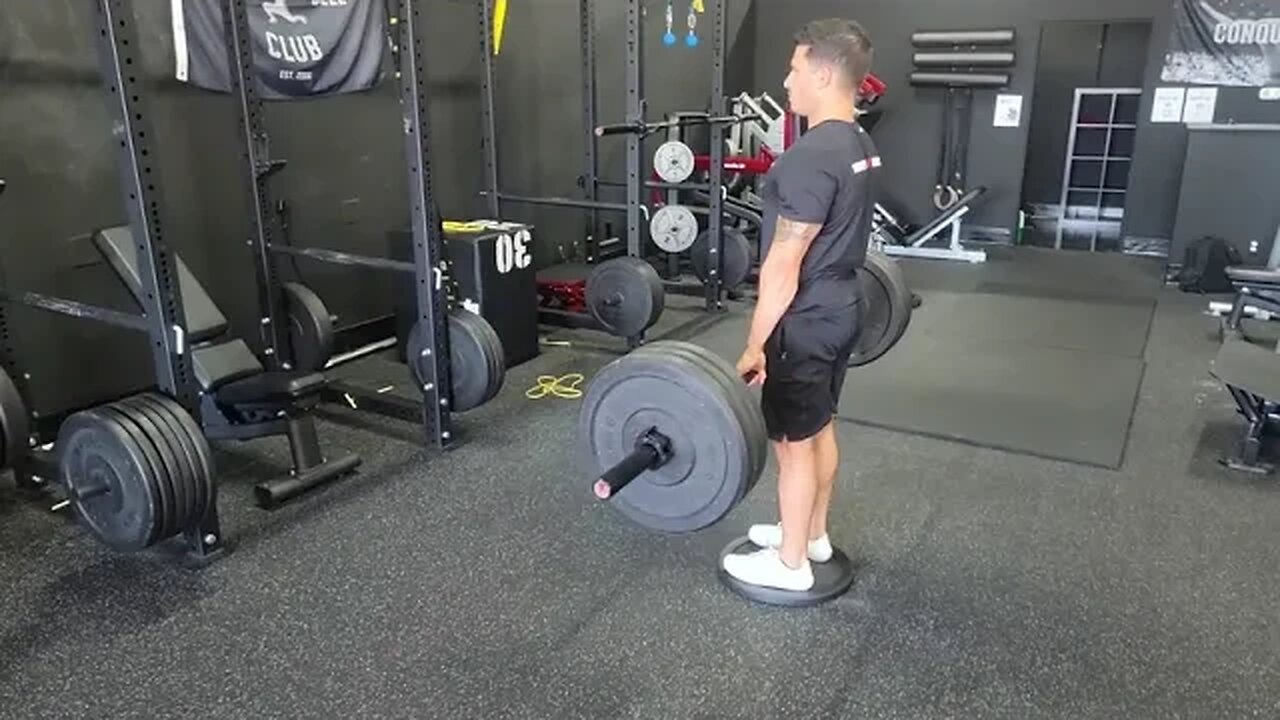Premium Only Content

Deficit Conventional Deadlift
Use bumper plates or deadlift blocks to stand on to make a ~1-2 inch deficit depending on your programming. If you normally put the bar mid foot, you may need to have the bar slightly more forward to avoid the knees when doing deadlifts at a deficit as it changes your leverage. Grab the bar evenly with each arm at shoulder width. Your hands should be wider than your feet so your legs will fit inside the width of your arms. Hold onto the bar and wiggle your hips down and back until your shoulders are directly over the bar, chest is facing forward, and your back is tight with a neutral spine. “Snap the bar in half” by driving the elbows back, putting more force into the pinky’s. This will protect your back by tightening the lats to avoid rounding in the spine and creating more whole body tension. Pull tight on the bar before lifting to take the “slack” out of the bar. You will hear a click where the bar pulls up on the center hole of the plates. Once you are fully engaged and super tight, drive the hips forward while pulling on the bar until you are standing straight up with your abs and glutes squeezed. Your spine should be neutral (or in a visibly straight line) throughout the lift. Start the descent of the bar by sitting your hips backward and bending the knees until the plates rest on the floor and the bar is over the mid-foot. Re-grip if you need to and repeat these steps for repetitions.
Trainer Tip: We want the bar path to be on the path of least resistance which is straight up and down. If you don’t hinge properly on the way down the bar will move forward or backward and mess up your alignment causing excessive rounding of the back. Focus on driving the hips forward and backward throughout the lift. This is a cue most people don’t hear and will help you avoid jerking the bar with your arms and potentially hurting your neck or your back.
-
 LIVE
LIVE
Redacted News
1 hour agoBREAKING! DEEP STATE SWAMP RATS TRYING TO SABOTAGE TRUMP FROM THE INSIDE | Redacted w Clayton Morris
10,740 watching -
 DVR
DVR
In The Litter Box w/ Jewels & Catturd
20 hours agoSUCK IT UP! | In the Litter Box w/ Jewels & Catturd – Ep. 691 – 11/14/2024
17.7K10 -
 10:13
10:13
Mike Tyson
2 hours ago $1.35 earnedThe Will Determines the Skill | BEHIND THE MIKE #007
6.04K3 -
 LIVE
LIVE
The Officer Tatum
37 minutes agoLIVE: Liberals MELT DOWN Over Trump and Biden Meeting, Al Sharpton EXPOSED
1,327 watching -
 30:53
30:53
Chef Donny
2 hours agoWhipping Up The Best Thanksgiving Mashed Potatoes with Rudy Junda | Chef Donny @Pepsi Live Stream
315 -
 59:15
59:15
Matt Kim
13 hours agoQuestions You’re Not Allowed to Ask After Trump’s Win | Matt Kim #124
3.15K2 -
 LIVE
LIVE
Mally_Mouse
2 hours agoLet's Play!!
237 watching -
 15:30
15:30
Bussin' With The Boys
3 hours agoHARDY Tells All About The World Of Writing Music
2.96K -
 2:17:36
2:17:36
vivafrei
4 hours agoThe Onion Buys/Shuts Down InfoWars? Trump Appointments Cause More Lefty Meltdowns & MORE! Viva Frei
65.1K22 -
 LIVE
LIVE
Rance's Gaming Corner
3 hours ago"Let a woman learn in silence with all submission."
251 watching